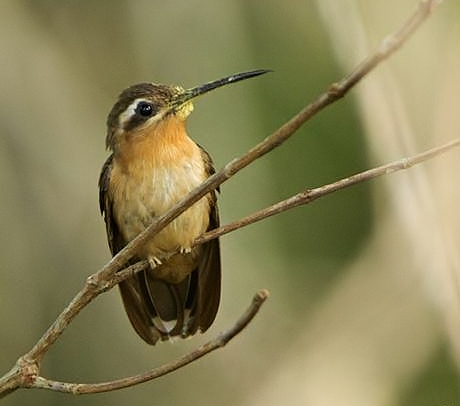 |
| Photo by Ciro Albano (Internet Bird Collection) |
Common name:
hook-billed hermit (en); balança-rabo-canela (pt); ermite de Dohrn (fr); ermitaño de Espírito Santo (es); bronzeschwanz-schattenkolibri (de)
Taxonomy:
Order Apodiformes
Family Trochilidae
Range:
This species is endemic to south-eastern Brazil. In was originally found along the coast from southern Bahia to northern Rio de Janeiro, but it is now only found in a few scattered sites within this former range, namely Porto Seguro, Monte Pascoal National Park, Serra de Itamaruja and Linhares Forest Reserve.
Size:
These birds are 12-14 cm long.
Habitat:
The hook-billed hermit is only found in lowland primary rainforests, especially inside closed-canopy forests and in damp areas along streams. They occur from sea level up to an altitude of 500 m.
Diet:
They feed mainly on the nectar of various flowers, but also hunt small arthropods.
Breeding:
Hook-billed hermits breed in September-February. The males are polygynous, having no further part in the breeding process after mating with the females. The female builds the nest, an elongated cup made of fine roots and plant fibres, often adorned with lichens and suspended from the leaves of a palm tree or Heliconia. There she lays 2 white eggs, which she incubates alone for 14-16 days. The chicks are fed by the female and fledge 20-30 days after hatching.
Conservation:
IUCN status – EN (Endangered)
This species has a small and fragmented breeding range, and the global population is estimated at just 250-1000 individuals. The population is suspected to be declining at a moderate rate, mainly due to habitat destruction and fragmentation caused by massive deforestation taking place within their range. Fires, the construction of roads are further threats. The existing nature reserves seem to provide inadequate protection as they are under threat from settler, fires spreading from surrounding farmland and expansion of roads, and
protect few watercourses that form key habitat for this species.







